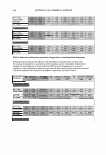HS-SPME-GC DETERMINATION OF FORMALDEHYDE 345 Supleco) an inlet liner for SPME (0.75 mm ID, Supelco) and a capillary column (HP-1 methyl siloxane, 30 m x 0.25 mm x 0.25 µm film thickness, Agilent). PREPARATION OF SOLUTIONS Preparation of 25% sodium chloride solution. The proper amount of sodium chloride was dissolved in HPLC-grade water. Preparation of 1.5 mM pentafluorophenylhydrazine (PFPH). The proper amount of PFPH was dissolved in HPLC-grade water. This solution was used as a derivatization agent in the present work. Preparation of 0.5000 mMJ 0.2500 mMJ 0.1250 mMJ 0.0625 mMJ 0.0313 mMJ and 0.0010 mM of formaldehyde stock standard solutions These solutions were prepared using 3 7 % formaldehyde solution (assayed as per EPA method 8315A) and diluted with formaldehyde-free sodium lauryl sulfate (Sulfochem SLS-BZ). Preparation of 0.5 mM deuterated acetone stock internal standard solution. The proper amount of acetone was dissolved with 25% aqueous solution of sodium chloride. Preparation of surfactants and cosmetic products (formaldehyde-free) Jpiked with formaldehyde To determine the recovery and precision of the current method, samples of raw materials and cosmetic products that were spiked with formaldehyde (0.05%) were analyzed ten times. The coefficient of variation (CV%) and recovery for each spiked sample was calculated. Another spiked sample (15 µg/ml) of surfactant was also analyzed eight times to determine the limit of detection (LOD), with calculated signal-to-noise ratio = 3 (S/N = 3). PROCEDURE Hydrozone. Pentafluorophenylhydrazine reacts with aldehydes and the ketones group by nucleophilic addition to the carbonyl group followed by elimination of water and the formation of pentafluorophenylhydrozone. The addition of acid, in general, is recom mended to promote protonation of the carbonyl because hydrazines are weak nucleo philes. However, this phenomenon was not observed during the study (see Figure 1). Calibration standard for hydrozone derivative. We prepared at least five concentration levels of spiked formaldehyde in formaldehyde-free sodium lauryl sulfate. We added into a ✓ .: ::CH2 F NH2 F N;::::;,-- I I F NH HYO F NH + ===== F F H - H 20 F F F F (pentafluorophenyl)hydrazine formaldehyde formaldehyde (pentafl uorophenyl )hydrazone Figure 1. Reaction between pentafluorophenylhydrazine and formaldehyde to form the respective hydra zone.
346 JOURNAL OF COSMETIC SCIENCE 10-ml PTFE screw-capped vial 1 ml of 1.5 mM of PFPH solution, 0.5 ml of 0.5 mM deuterated acetone, and 0.5 ml of 0.5 mM formaldehyde concentration. We placed the vial into a temperature-controlled heating block at 35°C after sonication for five min utes. We inserted SPME fiber in the heads pace of the vial for an adsorption period of 15 minutes. After the adsorption step, the fiber was directly inserted into the GC injector, in which the analytes were thermally desorbed at 250°C. To obtain a complete desorp tion, the SPME fiber was allowed to stay in the injection port for five minutes. For successive analysis of samples in this work, the SPME fiber was always first exposed onto the GC injector port as a blank run before the next experiment, to make sure the fiber was clean as well as to avoid the carryover effects. We repeated the experiment using 0.25 mM, 0.125 mM, 0.0625 mM, 0.0313 mM, and 0.0010 mM of formaldehyde concentrations in the same manner as before, to establish the calibration curve. The experiments were performed in triplicate. A plot was generated by using formaldehyde concentration vs peak area ratio: formaldehyde derivative/IS derivative (Table I, Figure 2). Sample preparation for the determination of formaldehyde content. Various categories of cos metic products and raw materials were used in this study: nail polish, shower gel, make-up foundation, and surfactant. All raw materials and cosmetics samples employed in this work were prepared as follows: We weighed 0. 50 g of sample into a 50-ml volumetric flask, added 20 ml of water, and sonicated for 15 minutes. We diluted to volume with water and mixed well (filtering if necessary). We pipetted 0.5 ml of the above solution into a 10-ml heads pace PTFE-capped vial, then added 1 ml of 1. 5 mM of PFPH solution and 0.5 ml of 0.5 mM deuterated acetone. We sonicated for five minutes and placed the vial into a temperature-controlled heating block at 35°C. We inserted SPME fiber into the headspace of the vial for an adsorption period of 15 minutes. After the adsorption step, the fiber was directly inserted into the GC injector, in which the analytes were thermally desorbed at 250 ° C. To obtain a complete desorp tion, the SPME fiber was allowed to stay in the injection port for five minutes. Chromatographic conditions • Column: non-polar HP-1 • Injector temperature: 250°C, splitless • Carrier gas: helium • Oven temperature: 100°C (5 min), 10°C/min, to 300°C. • Detector temperature (FID): 275°C • Flow: 1.2 ml/min Table I Concentration vs Peak Area Rado Concentration (µg/ml) 17.7000 8.8500 4.4250 2.2125 1.1063 0.0350 0.0000 Peak area ratio 9.538 4.590 2.128 1.231 0.692 0.026 0.000
Purchased for the exclusive use of nofirst nolast (unknown) From: SCC Media Library & Resource Center (library.scconline.org)






































































































